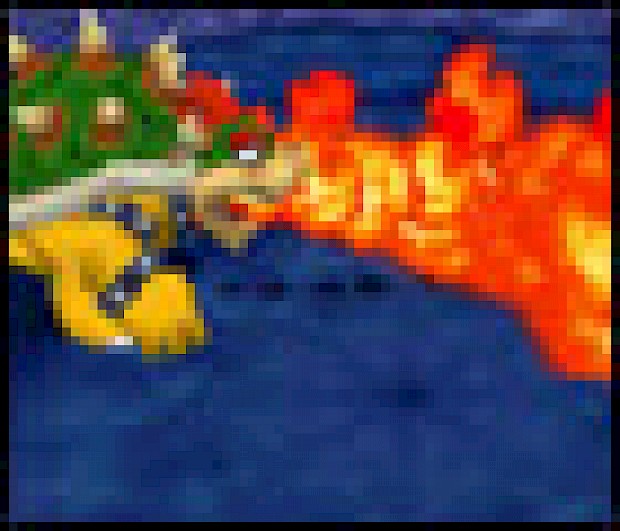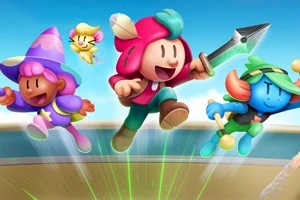Feature: Mario 64 Retrospective

Posted 27 Nov 2007 at 11:45 by Tom Phillips

Written by Nick Bennett
The Super Mario series has always been revered in gaming, occupying a special place in the video games hall of fame. Earlier this year, a panel of experts named Super Mario Bros. 3 as one of the top 10 most important video games of all time. That platformer, along with the original Super Mario Bros. the sublime Super Mario World, and critically and commercial success that is Super Mario Galaxy all stand as gaming landmarks.
But for me, Mario's 64-bit outing is the one adventure I have returned to again and again since its release over 10 years ago. Summer saw the release of Edge's top 100 games of all time, with the title being named in third place, just behind top ranked Zelda: Ocarina of Time and Resident Evil 4. And with the recent release of Super Mario Galaxy, what better time to revisit this classic?
It Was 10 Years Ago Today
To try and understand what makes Super Mario 64 great is like trying to explain the legacy of Sgt. Pepper's Lonely Hearts Club Band. During the years preceding 1997, Shigeru Miyamoto and the Nintendo team had designed and refined the most venerated 2D platform series in history. To take the spirit of that design and translate it in its entirety to 3D was a staggering achievement.
So many other 16-bit titles had already fallen short, as programmers in the mid-1990s lost their way in the rush to exploit full 3D graphics. Miyamoto understood that the graphics were only a means to an end, and that the real goal was to provide gamers with a new experience, while remaining true to the original Mario series. >
Enough of the hyperbole. Instead, let me set out the two reasons why the title is one of the all-time greats.
Power Steering
The mark of a great platformer is whether or not gamers feel free in their virtual environments, and in this respect controls are crucial. The game is a landmark title because of its pioneering use of the analog stick, the centre-piece of the N64 joypad which has defined gaming for the last decade. Why is this so important?
First, the degree of control remains unsurpassed. Mario is able to tiptoe, walk and run at full tilt, all with varying pressure on the analog stick. From creeping up on snoozing Piranha Plants, to barrelling over hot sands, to sliding down hillsides, the analog stick offers full three-dimensional freedom. We all remember circling the stick 360 degrees to hurl Bowser into the air like a discus-thrower, but it is the depth of gameplay that was achieved with the sensitive analogue stick that defined the game.
Mario's range of moves has never been bettered: no other character has been so controllable. Some gamers have argued that subsequent platformers have advanced the degree of control seen in Super Mario 64. This just isn't possible, since there is nothing that is beyond Mario, no ledge that cannot be reached. Among Mario's many moves is the ability to tiptoe, run, dive and slide; duck, crawl and roll. Mario can also long jump, triple jump, back flip and wall kick. He can shoot himself out of a cannon, fly through the air, stomp on Goombas, punch and kick enemies, and surf on Koopa shells. And he can climb trees, and slide down chutes. And he can swim to great depths. Oh � and he can cling onto ledges (which a lot of supposedly superior platform stars are simply incapable of doing: what, no fingers?) and to my mind is an absolute necessity when vaulting over bottomless pits. Hanging on to ledges should have been an industry standard ever since the Prince in 1989's original Prince of Persia clawed his way up platforms.
More than this, the plumber's dives, jumps and kicks can be woven together into seamless combinations. Take the triple jump, often needed to clear tall obstacles. From a standing start you can break Mario into a run, hit A to leap, and then hit A twice in succession just as Mario's feet hit the ground, vaulting him into the air. And this can be combined with other moves: so Mario can dive and belly flop, then right himself with a short somersault. Back on his feet, and still gunning forward, you can pull the analogue stick back and launch Mario into a back flip. Everyone who's played this game knows how easy these moves are to string together, how graceful and fluid they look and how satisfying they feel. Not just fun, but functional, these controls have to be mastered to push Mario through tight spaces or over long distances.
The short plumber may not look like an athlete, but Mario is one of video gaming's free running experts. To put simply � when I play another game that allows me to do all of this, or maybe even just this, then I'll accept that Mario has had his day.
The instruction manual and YouTube video above convey the sublime brilliance of the controls, but do not touch on another factor in Mario's ongoing 64-bit greatness � the intuitive nature of those controls. Not only does Mario have demonstrably more moves than any other platformer, but his jumps are easy to learn� though admittedly hard to master.
I learned to drive in a diesel engine Ford Fiesta, and I wrestled the steering wheel when toiling through three-point turns. After I passed my test I jumped into a car with power steering, amazed that I was now able to execute those grinding three-pointers with grace. Playing Super Mario 64 is like using power steering for the first time � at last, able to control the action with ease, your character sensing where you want to go. Anything less than Mario is just like grappling with that old unresponsive diesel car.
The controls guide players through the worlds of the game � the obstacles and pits and enemies that must be overcome. This leads me to the second reason why Mario's 64-bit adventure remains timeless.
Virtual Sandbox
Freedom in video games is unattainable � there are always boundaries and constraints, both visible and invisible; there are always areas that you cannot reach. And there are restrictions on what your character can do in relation to this environment. Yet a great designer can create the illusion of freedom, and this is subtly achieved.
Building on the influential non-linear structure of its 2D predecessors, the game allows the player to roam through Princess Peach's Castle, a hub leading to 15 different worlds, each containing unique challenges that must be overcome for Power Stars. This hub world has been imitated but never improved upon. The non-linear design gives players the freedom to dip in and out of levels: to either focus on beating certain missions, or to attempt something new if you are feeling frustrated. You are not constrained in anyway. You can follow your own path and set your own difficulty curve.
This non-linearity has become so ingrained in game design that it's impossible to remember a time when Point A to B was gaming bread and butter. Everything from first-person shooter GoldenEye (former Rare designer Martin Hollis noted the influence of Mario on the multiple-mission structure of the 007 classic) to the urban sprawl of the Grand Theft Auto series has borrowed from this design. Other 3D platformers have sponged off Super Mario 64 and created bloated, sprawling overworlds. This misses the point. The castle structure, and its variety of paths and missions that can be tackled in tandem, affords the player complete control and an unprecedented degree of freedom to explore � but at the same time is manageable. If it's giant environments you want, you can find them in adventures, because Hyrule this ain't. Mario's environment consists of one hub world to explore from top to bottom, with 15 distinct levels branching off. You soon learn every nook and cranny of the castle, and appreciate that if one challenge is proving too frustrating, another level is waiting behind a different painting portal, just a short run down the hall. It is this manageability that makes the title a pure joy to play.
This world ranges from the wide-open, training mission of Bob-omb Battlefield to the ambience of Jolly Roger Bay. There is a concentration on pure, abstract platforming in Whomp's Fortress and Lethal Lava Land. The expansive Shifting Sand Land features a complex pyramid level within a level. Both Wet-Dry World and Tiny-Huge Island require the player to manipulate the levels themselves� in the former, the water level can rise or fall, allowing previously inaccessible areas to open up; in the latter, Mario can shrink to miniature size to battle giant Goombas or grow to a giant to jump over tiny platforms. The concept is taken further in Tick Tock Clock, as the cogs and gears of this giant grandfather clock alter, depending on the placement of the hands when Mario enters the level. And the game's final world, Rainbow Ride, is pure platforming challenge: bad language follows even the slightest mistake as Mario's jumps have to placed exactly on small ledges and magic carpets all suspended in mid-air. In the end, Super Mario 64 consists of 15 brilliantly designed and defined virtual sandboxes � 15 different levels in which to use all of Mario's many moves, jumps and leaps.
Anything else?
With all this talk of design and controls I've not even touched on the graphics or music that perfectly complements this classic. The Beatles connection again � the game features a psychedelic fantasy world (magic mushrooms, anyone?), a cheery, colourful backdrop in which to explore and to defeat not-so-scary Piranha Plants and other meanies. The music and sound effects set the pleasant, cheery tone of the game. And Super Mario 64 is also the only videogame I can think of that makes inspired use of a sitar � and that sure worked for the Fab Four.
The Last Word
No other 3D platformer has came close to the legacy of gaming milestone, though we all have high hopes for Galaxy. I'll leave the last word to Warren Spector: "It's not possible to squeeze this much gameplay into a single game. Mario has, like, ten things he can do and yet there's never a moment where you feel constrained in any way. No game has done a better job of showing goals before they can be attained, allowing players to make a plan and execute on it. And the way the game allows players to explore the same spaces several times while revealing something new each time is a revelation. Any developer who wouldn't kill to have made this game is nuts."
Nick Bennett,
nicholas @ n-europe.com






















